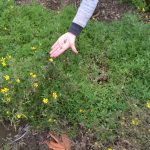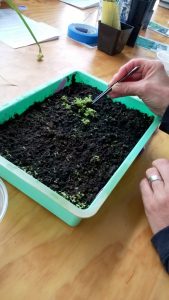A Nod For Natives
October 16, 2017
These days I hang out with volunteers of the Washington Native Plant Society (WNPS). I don’t tend to say much. I know my place (right field).
These are pleasant knowledgeable folks and I am learning a lot. One member coaxed me to sign  up for a native plant propagation class at Oxbox Farm last Saturday. It was fantastic. Bridget McNassar is a trained teacher and has been working in their nursery for five years. The nursery is pristine. I asked if I needed to take my shoes off. Check out those hanging hoses.
up for a native plant propagation class at Oxbox Farm last Saturday. It was fantastic. Bridget McNassar is a trained teacher and has been working in their nursery for five years. The nursery is pristine. I asked if I needed to take my shoes off. Check out those hanging hoses.
She covered seed collecting, cleaning and  storage and showed us when a seed head is ready for collection. In the photo she collects seeds from the flowering Oregon Sunshine (Eriophyllum lanatum).
storage and showed us when a seed head is ready for collection. In the photo she collects seeds from the flowering Oregon Sunshine (Eriophyllum lanatum).
We reviewed germination, including the issue of dormancy, and Bridget graciously provided us with Swordfern spores to take home. In the photo, she is patching out. She takes a fern that has emerged and  plucks it out and pushes it into a bare area of the same medium (bark and compost).
plucks it out and pushes it into a bare area of the same medium (bark and compost).
Sun, Dec 17, 2-4, Work Party
Sun, Jan 21, 2-4, Work Party
She offered several types of seeds for us to take and gave us the link to the website Native Plant Propagation Protocol Database so we could look up how many days we had to keep some of our seeds in the refrigerator (cold stratification) before we tried to sow them. Salal needs 42-100 cold days so I will put the seeds in the refrigerator in mid-winter for spring planting.
The class size was small so questions were answered, either by Bridget or by a high school boy scout quite familiar with the Latin names of plants!
Tips from Bridget:
A seed is not mature if you can dent it with your fingernail
Consider a food processor with a plastic dull “blade” to separate pulp from seed for fleshy fruit
A good way to scarify seeds is to rub them between two sanding blocks
Simple cotton bags work well to dry seeds
Make sure seeds are dry and cold for storage
The 6 mil plastic zip lock bags don’t let gases through in the refrigerator
Be patient! Trillium can take three years
There are still two sessions left of this class – Saturday October 21 and October 28
You can use your phone to start your native wildflower education. Those hard-working people at the Burke Museum have a smartphone app at https://www.pnwflowers.com/app
Help is with our own native plant area at the south end of the orchard at the next work party. We just acquired a Scouler’s Willow (Salix scouleriana), the most drought tolerant of the natives.
Ruth


Leave a Reply
Want to join the discussion?Feel free to contribute!